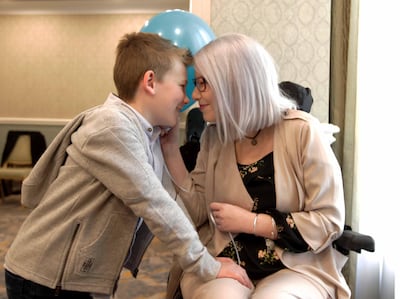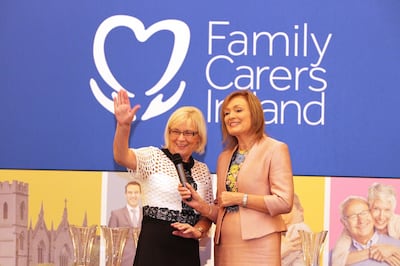Dorothy Meaney has two grown-up children. While her son, Jonathon, lives and works in Spain, her daughter Zondra lives at home and needs round-the-clock care, as she suffers from the debilitating condition Ehlers-Danlos Syndrome (EDS).
The 32-year-old had health issues when she was growing up, but was not diagnosed with anything specific. Then, after leaving school, despite many puzzling and debilitating ailments, she managed to attend college. And, 10 years ago, she gave birth to her son, Carrick.
However, ill-health still ruled her life and, five years ago, doctors revealed she had a condition which affects just one in 5,000 people. Since then, her health has deteriorated and mum Dorothy, her full-time carer, says life can be tough.
“Zondra was born with a heart murmur and was always back and forth to hospital,” she recalls. “Doctors also thought she had ‘click hips’, but eventually said it was nothing to worry about. However, looking back, I think this was the first sign of problems yet to come.
“She also suffered very badly with migraines and with her bowels and stomach, which would cause her to scream with the pain. And over the years she had so many broken and dislocated bones that I thought I would be reported to social services.”
Blackouts
When Zondra was 14, she began to have blackouts and her mother was advised this was due to panic attacks and she should carry a paper bag with her to help restore calm breathing. She wasn’t convinced and continued to look for answers to her daughter’s ever-growing list of issues.
“Life has not been easy for me over the years and most of it has been stolen by EDS,” says Zondra. “Over the years , I went to various doctors, but was never given any explanation as to what was wrong. So I carried on as normally as possible and after school went on to study beauty therapy. But I didn’t have enough strength for the job as one day I collapsed at work and was rushed to hospital, where it was decided that that I had a ‘muscle weakness’.
“I went on to study science which I really loved and it was a bit easier than the beauty therapy even though I was on my feet all day. But even that became too much for me and, at 25, I was diagnosed with postural tachcardia syndrome (PoTS) which can cause abnormal increase in heart rate and result in dizziness and fainting. So we now had an explanation for the blackouts, but were left wondering why I had so many other problems.
"A private rheumatologist [who she attended as there was a three-year wait on the public system] suggested I may have Ehlers Danlos Syndrome so, in 2014, we travelled to the St John and Elizabeth Hospital in London where I was officially diagnosed with EDS."
Constant pain
EDS differs from person to person and Zondra has problems with her skin, joints, tendons, ligaments, bowels, stomach and blood vessels. She was also diagnosed with Chiari Malformation, which affects less than 20 per cent of EDS patients and causes severe headaches and problems with eyesight and muscle strength. The complexity of Zondra’s condition means she and her mother have to travel to London every three months to be seen by specialists and receive treatment to try and alleviate the constant pain.
“I am in pain every day and sometimes it is almost too much to bear,” she says. “I spend a lot of my time in bed or in a wheelchair and really I couldn’t manage at all without my mother. She does so much for me and Carrick, and this allows me to have some time with him every day and be a regular parent rather than a ‘sick’ one.

“She shields him from the worst of it, so I get to be up and on the sofa when he comes home from school and I can also do homework with him and have dinner. Without my mother, I wouldn’t be able to cope at all as I am now completely housebound. I have lost so much – the person I was before EDS, my career, my contact with the outside world and my zest for life, but I am still determined to keep going and, thanks to her, I can stay somewhat positive.”
Caring for Zondra is no easy task, but her devoted mother says it is her first priority in life. "I never thought of myself as a carer as I just do what I have to do," says Dorothy. "My mind is always on my daughter and I feel no one can mind her like I do. The life of a carer can be lonely, because sometimes people find it hard to understand that I can't just drop things and go out, as I can't plan because I never know what way Zondra will be. But Family Carer's Ireland is a huge support to all carers – they fight our corner for us when we probably wouldn't have the time or energy to do it for ourselves."
The Limerick woman says that despite the hardship, her daughter is upbeat and gets great joy from both life and her beloved son – so she is also determined to look on the bright side of life. "Zondra needs a lot of treatment [including surgery abroad on her skull which is becoming dislocated from her neck] and thankfully her friends have started to try and raise funds – as it is so expensive [see their gofundme page]. She had a pulmonary embolism in October on top of everything, but she still remains positive and tries to carry on as normally as possible. Carrick is her greatest joy and the reason she stays fighting no matter what life throws at her.
‘Strong and positive’
“I take care of everything for her, but although it’s tough, things are far, far worse for her. Neither of us are living the life we envisaged and sometimes I wish things were different, but when I see how strong and positive my daughter is, how can I be any different?”
Natalie Murphy, founder of EDS Awareness Ireland, explains what the condition is and how it manifests itself. "The Ehlers-Danlos syndromes are a group of connective tissue disorders which have 13 subtypes," she says. "Connective tissue is important in the body as it is the 'glue' which holds organs, joints and blood vessels in place. In those with EDS, this glue is more like 'chewing gum', making the affected body systems weak and stretchy.

"At this time, research statistics show the total prevalence as one in 2,500 to one in 5,000 people, which means there could be up to 1,900 people in Ireland affected. Many patients live their lives without answers and suffer with the condition well into adulthood before the right clinician finally puts all the pieces together. Since 2011, EDS Awareness Ireland has connected and offered support to more than 600 people living with the condition in Ireland, and is also committed to raising national awareness.
“The syndromes are also not currently recognised on the long-term illness scheme, though they are genetic and lifelong. Many patients are forced to travel to the UK, USA and various other countries privately to attain diagnosis and treatment. These medical trips can cost thousands of euro and place undue stress on the patients and their families.”
About EDS
– The symptoms and prognosis vary depending on the type of EDS diagnosed, the age at diagnosis and the individual.
– EDS has many secondary conditions such as dysfunction of the autonomic nervous system and gastrointestinal issues.
– The symptoms can in some cases be extremely disabling, impacting patients' school work, career progression, relationships and mental health due to the nature of the disorder.
– Early diagnosis leads to early intervention which can dramatically improve a patient's quality of life.
– Genetic testing is available for each of the subtypes except Hypermobile EDS, which is diagnosed through clinical investigations. Unfortunately, Hypermobile EDS is considered vastly underdiagnosed in Ireland as there is no clinical Ehlers-Danlos syndrome specialist appointed by the HSE.
– Life expectancy can be shortened for those with the Vascular EDS due to the possibility of organ and vessel rupture. But life expectancy is usually not affected in the other types.
– There can be a wide or narrow range of severity within a family, but each person's case of EDS will be unique.
– While there is no cure for the Ehlers-Danlos syndromes, there is treatment for symptoms and there are preventative measures that are helpful for most.
Read: 'Even unwashed and medicated up to my eyes, Martin makes me feel beautiful'











